
A national flag is a flag that represents and symbolizes a given nation. It is flown by the government of that nation, but can also be flown by its citizens. A national flag is typically designed with specific meanings for its colours and symbols, which may also be used separately from the flag as a symbol of the nation. The design of a national flag is sometimes altered after the occurrence of important historical events. The burning or destruction of a national flag is a greatly symbolic act.

The national flag of Libya was originally introduced in 1951, following the creation of the Kingdom of Libya. It was designed by Omar Faiek Shennib and approved by King Idris Al Senussi who comprised the UN delegation representing the three regions of Cyrenaica, Fezzan, and Tripolitania at UN unification discussions.
As a result of the Syrian Civil War since 2011, there are at least two flags used to represent Syria, used by different factions in the war. The incumbent government of the Syrian Arab Republic led by the Ba'ath Party uses the red-white-black tricolour originally used by the United Arab Republic, while Syrian opposition factions such as the Syrian National Coalition use the green-white-black tricolour known as the ''Independence flag'', first used by Mandatory Syria.
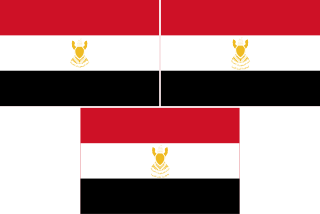
The Federation of Arab Republics was an unsuccessful attempt by Muammar Gaddafi to merge Libya, Egypt and Syria in order to create a unified Arab state. Although approved by a referendum in each country on 1 September 1971, the three countries disagreed on the specific terms of the merger. The federation lasted from 1 January 1972 to 19 November 1977.

Since 2011, Libya currently does not have an official national emblem. The Constitutional Declaration issued by the National Transitional Council on August 2011 defines the flag of Libya, but does not make any provisions for a coat of arms.

Muammar Gaddafi became the de facto leader of Libya on 1 September 1969 after leading a group of young Libyan Army officers against King Idris I in a bloodless coup d'état. After the king had fled the country, the Revolutionary Command Council (RCC) headed by Gaddafi abolished the monarchy and the old constitution and established the Libyan Arab Republic, with the motto "freedom, socialism and unity".

The Kingdom of Libya, known as the United Kingdom of Libya from 1951 to 1963, was a constitutional monarchy in North Africa that came into existence upon independence on 24 December 1951 and lasted until a bloodless coup d'état on 1 September 1969. The coup, led by Muammar Gaddafi, overthrew King Idris and established the Libyan Arab Republic.
The following outline is provided as an overview of and topical guide to Libya:
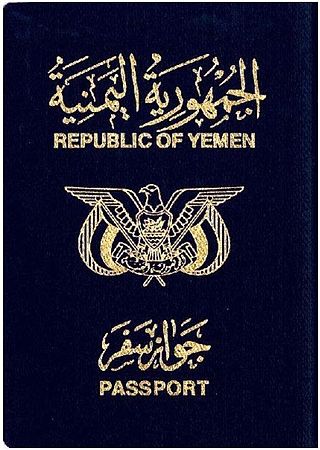
A Yemeni passport is a government document used by citizens of Yemen for international travel. Yemeni passports are issued by the Immigration and Naturalization Service of the Ministry of the Interior, and by some Yemeni consulates and embassies around the world.

Visa requirements for Emirati citizens are administrative entry restrictions by the authorities of other states placed on citizens of the United Arab Emirates (UAE).

Visa requirements for South African citizens are administrative entry restrictions by the authorities of other states placed on citizens of the Republic of South Africa. As of 13 April 2021, South African citizens had visa-free or visa on arrival access to 108 countries and territories, ranking the South African passport 45th in terms of travel freedom according to the Global Passport power Rank 2023 report

The 1951 Libyan Constitution was brought into force on 7 October 1951, prior to Libya's formal declaration of its independence on 21 December 1951 as a constitutional and hereditary monarchy under King Idris. The enactment of the Libyan Constitution was significant in that it was the first and only piece of legislation that formally entrenched the rights of Libyan citizens after the post-war creation of the Libyan nation state.
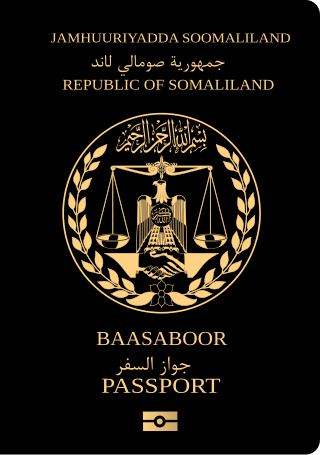
The Somaliland passport is the passport issued to citizens of the unrecognized country of Somaliland for international travel. A passport was issued for the first time in 1996, and a biometric passport was in 2014, in line with new global standards and the requirements of the International Civil Aviation Organization.

The Libyan Armed Forces or the Libyan Arab Armed Forces are, in principle, the state organisation responsible for the military defence of Libya, including ground, air and naval forces.

The 1969 Libyan revolution, al-Fateh Revolution or 1 September Revolution, was a coup d'état and revolution carried out by the Free Officers Movement, led by Colonel Muammar Gaddafi, which overthrew the Senussi monarchy of King Idris I and resulted in the formation of the Libyan Arab Republic.
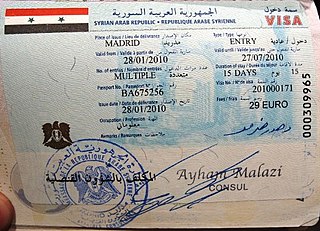
Before the start of protests, hostilities and conflicts and the start of the devastating Civil war in Syria in 2011, citizens of many Asian, European, African and American countries could visit Syrian Arab Republic without a visa or get a visa on arrival, gradually Syria began to cancel visa-free entry and visa on arrival for many countries, and in 2014 the Syrian authorities officially announced the introduction of a visa regime for all countries. However, until now, citizens of some states can de facto enter Syria without a visa or receive a visa on arrival. The visa policy of Syria is now extremely unstable, and there is no exact data on the visa policy of this country. This data is taken from open sources and may become outdated or irrelevant. When entering Syria, the Syrian authorities ask to obtain a Syrian visa in advance by contacting one of the country's diplomatic missions in the world.

Visitors to Egypt must obtain a visa from one of the Egyptian diplomatic missions unless they come from one of the visa exempt countries or countries that are eligible for visa on arrival. Visitors must hold passports that are valid for at least 6 months from the date of arrival to Egypt.
A national coat of arms is a symbol which denotes an independent state in the form of a heraldic achievement. While a national flag is usually used by the population at large and is flown outside and on ships, a national coat of arms is normally considered a symbol of the government or the head of state personally and tends to be used in print, on armorial ware, and as a wall decoration in official buildings. The royal arms of a monarchy, which may be identical to the national arms, are sometimes described as arms of dominion or arms of sovereignty.

The flag of Libya from 1977 to 2011 was the flag of the Socialist People's Libyan Arab Jamahiriya from 1977 to 1986 and the flag of the Great Socialist People's Libyan Arab Jamahiriya to 2011. The design is a green field in 1:2 ratio and was considered the only solid colour national flag in the world during its time.
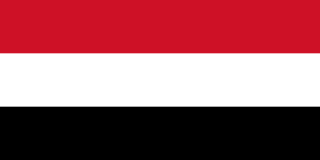
The Free Officers Movement was a group of Arab nationalist and Nasserist officers in the Libyan Army that planned and carried out the 1969 Libyan coup d'état which deposed King Idris and the Libyan monarchy. It was led by a twelve-member cabinet known as the Revolutionary Command Council, whose chairman was Muammar Gaddafi, which came to govern the Libyan Arab Republic.


















